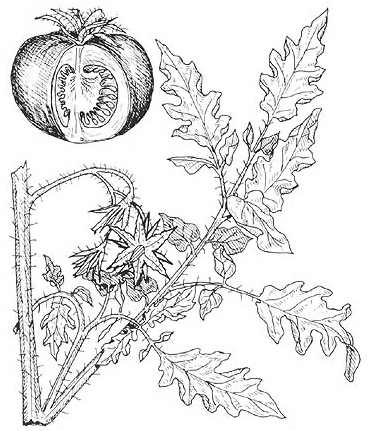Family: Solanaceae
Lycopersicon esculentum
Citation:
Miller, Gard. Dict. edn 8, no. 2 (1768).
Synonymy: Solanum lycopersicum L., Sp. Pl. 185 (1753); L. lycopersicum (L.)Karsten ex Farwell, Ann. Rep. Parks Detroit 11:83 (1900).
Common name: Tomato.
Description:
Herb, usually annual, with branches 1-1.5 m long, mostly densely glandular-pubescent, aromatic; leaves to 30 cm long, ovate in outline, deeply lobed to pinnatisect with 7-9 lobes; petiole 2-5 cm long.
Cymes to 20-flowered, peduncles simple or dichotomously branched; pedicels articulated near the middle; calyx lobes narrow-lanceolate; corolla to 25 mm diam., robes narrow-triangular, yellow; anthers 5-10 mm long including the appendage; ovary glabrous or pubescent.
Berry globular or depressed-globular, in cultivated forms multi-celled and irregularly lobed or ridged, 1-2 (rarely to 10) cm diam., usually red, rarely pink or yellowish; seeds 2-3 mm long, pilose, numerous.

| Flowering branch and opened fruit.
|
Image source: fig. 567A in Jessop J.P. & Toelken H.R. (Ed.) 1986. Flora of South Australia (4th edn).
|
Published illustration:
Masefield et al. (1969) Oxford book of food plants, p. 125.
|
|
Distribution:
|
all States except Tas. Native to the Andes of South America.
|
Conservation status:
naturalised
Flowering time: summer.
|

SA Distribution Map based
on current data relating to
specimens held in the
State Herbarium of South Australia
|
Biology:
No text
Uses:
The tomato is widely cultivated, sparingly adventive about picnic grounds and where sewage sludge is used.
Taxonomic notes:
Since Miller published the name Lycopersicon esculentum it has been widely accepted because the name Lycopersicon lycopersicum was regarded as an inadmissable tautonym, a fact nowadays often challenged because of the Greek and Latin ending of the two respective words. In view of the economic importance of the tomato Terrell et al. (1983) Taxon 32:310-314 have proposed the conservation of the widely used name L. esculentum over the older name L. lycopersicum (L.)Karsten ex Farwell.
Author:
Not yet available
|

